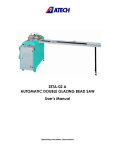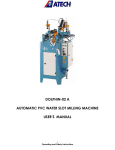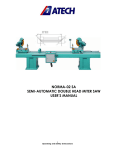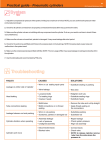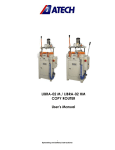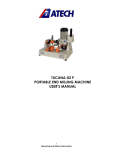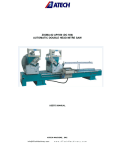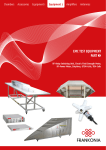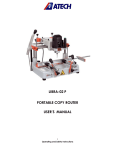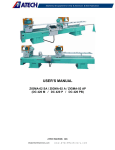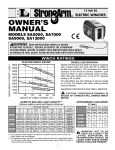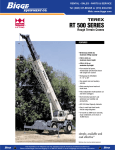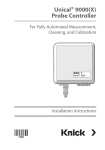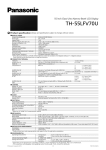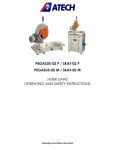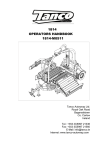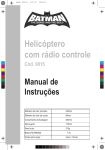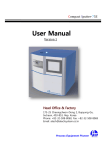Download phoenix-02 sh automatic single head pvc profile
Transcript
PHOENIX-02 SH AUTOMATIC SINGLE HEAD PVC PROFILE WELDING MACHINE USER’S MANUAL 1 Operating and Safety Instructions CONTENTS Page 1. General Information 1.1. Introduction 1.2. Manufacturer 2. Machine’s Description and Purpose of Use 2.1. Machine’s description 2.2. Technical features 2.3. Overall dimensions 2.4. Part list and technical drawings 3. Safety 3.1. Safety information 3.2. Accident prevention 3.3. General safety information 4. Transport of the Machine 5. Installation of the Machine 5.1. Preparation 5.2. Electric connection 5.3. Air pressure adjustment 6. Machine Safety Information 7. Operation 7.1. General 7.2. Buttons and displays on the machine 7.3. Welding operation 8. Maintenance 8.1. Periodic checks 8.2. Replacing and cleaning of the Teflon cover 8.3. Maintenance at the end of working day 9. Troubleshooting Guide 10. Electric and Pneumatic Components 10.1. Electric components 10.2. Pneumatic components 2 Operating and Safety Instructions 3 3 3 3 3 5 6 7 10 10 10 11 13 13 13 13 13 14 15 15 16 17 17 17 18 18 18 19 19 19 1. GENERAL INFORMATION 1.1. INTRODUCTION The user’s manual given by the manufacturer contains necessary information about the machine parts. Each machine operator should read these instructions carefully, and the machine should be operated after fully understanding them. Safe and efficient use of the machine for long term depends on understanding and following the instructions contained in this manual. The technical drawings and details contained in this manual constitute a guide for the operator. 1.2 DISTRIBUTOR ATech Machine, Inc. 10752-A Tucker Street – Beltsville, MD 20705 USA Phone: +1-301-595-1816 Fax: +1-301-560-6627 Website: www.ATechMachinery.com E-mail: [email protected] In case of any technical problem please contact your nearest ATECH dealer, or ATECH head office through the above mentioned phone fax or e-mail address. Technical labels with the model description of the machine are fixed onto the front side of each machine. The machine’s serial number and manufacturing year are stipulated on the technical label. 2. MACHINE’S DESCRIPTION AND PURPOSE OF USE 2.1 MACHINE’S DESCRIPTION Machine is designed for the joining of vinyl (PVC) profiles though corner welding. Capable of adjusting the clamp and welding pressure according to the profile type. Equipped with a timer for melting and welding time. Capable of welding at angels between 300 – 1800 Profiles are clamped one by one via foot pedal. After clamping the profiles, the welding is carried out automatically. The thermostat is electronic and can be adjusted in a temperature range between 00-2600 C. 3 Operating and Safety Instructions Please mention the below mentioned data in all your correspondence regarding the machine with the manufacturer and/or your ATECH dealer. *Machine model *Machine’s serial number *Voltage and frequency *Name of dealer where machine was purchased *Date of purchase *Description of the machine fault *Average daily operation period 4 Operating and Safety Instructions 2.2 TECHNICAL FEATURES Technical Features (American) PHOENIX-02 SH 1.5kW 120V 60Hz Max.h:5 " α=30°-180° 1,5kW 230V 50Hz Max.h:130 mm. α=30° - 180° 90-120 psi 1,25 CFM 31x34x55" 506 lb Technical Features (Metric) PHOENIX-02 SH 6-8 Bar 5 Operating and Safety Instructions 35l/min 78x85x140 mm 230 kg 2.3 OVERALL DIMENSIONS 6 Operating and Safety Instructions 2.4 PART LISTS AND TECHNICAL DRAWINGS Figure-1 NO 2 3 4 6 12 13 30 42 44 51 55 57 58 STOCK CODE 143-126 141-234 145-035 111-156 242-005 112-080 147-001 191-003 550-025 111-158 242-022 111-161 143-027 61 63 64 66 67 68 71 212-002 242-019 242-018 145-033 141-232 111-155 141-050 73 75 211-018 550-010 PART NAME PISTON HOUSING SHAFT CLAMP SHOE LEFT TABLE CLAMP COLUMN PISTON PAG Y 80x90 LEFT SET SQUARE SUPPORT PROFILE 6201 BEARING PIN CYLINDER RESISTANCE PLATE PISTON PMY 50x25 HEATING PLATE HOUSING HEATING PLATE HOUSING SHAFT FRAME PISTON PMY 40x170 PISTON PMY 32x50 GUIDE PLATE FORK SHAFT GUIDE BEARING HOUSING M16x55 FOOT ADJUSTMENT BOLT PANEL HANDLE 7 Operating and Safety Instructions QTY 4 2 1 2 2 2 2 1 2 1 1 1 2 1 1 1 1 1 1 2 1 2 Figure-2 8 Operating and Safety Instructions NO. PART NAME 1 STOCK CODE 145-039 QTY NO. TABLE ADJUSTM. DOWEL 2 59 STOCK CODE 145-037 2 3 4 6 7 8 9 12 13 15 18 143-026 141-234 145-035 111-156 111-162 111-159 143-028 242-005 112-080 145-035 141-243 PISTON HOUSING SHAFT CLAMP SHOE LEFT TABLE CLAMP COLUMN TABLE SHAFT HOUSING TABLE SHAFT HOUSING TABLE HOUSING SHAFT PISTON PAG Y 80x90 LEFT SET SQUARE RIGHT TABLE TABLE SHAFT HOUSING WASHER TEFLON WASHER 6201 BEARING PIN CYLINDER PISTON CONNECTION MOVEMENT HOUSING RESISTANCE PLATE TABLE PISTON CONNECT. PISTON PMY 50x25 HEATING PLATE HOUSING HEATING PLATE HOUSING SHAFT 4 2 1 2 4 2 2 2 2 1 2 63 64 65 66 67 68 70 242-019 242-018 145-034 145-033 141-232 111-155 176-004 19 43 44 45 48 51 54 55 57 58 142-034 191-003 550-025 111-157 111-154 111-158 111-160 242-022 111-161 143-027 4 2 2 2 1 1 1 1 1 2 9 Operating and Safety Instructions PART NAME HEATING PLATE HOUSING CONNECT. PLATE PISTON PMY 40x170 PISTON PMY 32x50 GUIDE PISTON PLATE GUIDE PLATE FORK SHAFT GUIDE BEARING HOUSING M12 BOLT QTY 1 1 1 1 1 1 1 1 3. SAFETY 3.1. SAFETY INFORMATION The symbols shown hereunder are necessary to be read with special attention. Not reading or observing of them may cause damage to the equipment or personal injury IMPORTANT The IMPORTANT symbol above is one telling to apply special care and to be careful at carrying out the specified operation. CAUTION ! The CAUTION! Symbol above warns you against specific dangers, and requires to read the text. Not observing may cause damage to the equipment. DANGER WARNING The DANGER WARNING above warns you against specific dangers, and definitely requires the text to read. Not observing may result in serious bodily injury. Please read the user’s manual carefully before using the machine or carrying out maintenance. 3.2. PREVENTION OF ACCIDENTS 3.2.1 Our machines are manufactured in accordance with EN 60204-1 and EN 292-2 CE safety directives, which cover national and international safety directives. 3.2.2 It is the task of the employer to warn his staff against accident risks, to train them on prevention of accidents, to provide for necessary safety equipment and devices for the operator’s safety. 3.2.3 Before starting to work with the machine, the operator should check the features of the machine, learn all details of the machine's operation. 10 Operating and Safety Instructions 3.2.4 The machine should be operated only by staff members, who have read and understood the contents of this manual. 3.2.5 All directives, recommendations and general safety rules contained in this manual have to be observed fully. The machine cannot be operated in any way for purposes other than those described herein. Otherwise, the manufacturer shall not be deemed responsible for any damages or injuries. And such circumstances would lead to the termination of the warranty. 3.3. GENERAL SAFETY INFORMATION 3.3.1. The power cable should be led in such a way that nobody can step on it or nothing can be placed on it. Special care has to be taken regarding the inlet and outlet sockets. 3.3.2. If the power cable should be damaged during operation, don't touch and unplug it. Never use damaged power cables. 3.3.3. Don’t overload machines for drilling and cutting. Your machine will operate more safely with power supply in accordance with the stipulated values. 3.3.4. Don’t place your hands between parts in motion. 3.3.5. Use protective eye glasses and ear plugs. Don't wear oversize clothes and jewels. These can be caught by moving parts. 3.3.6. Keep your working place always clean, dry and tidy for accident prevention and safe operation. 3.3.7. Use correct illumination for the safety of the operator. (ISO 8995-89 The Lighting of Indoor Work Systems) 11 Operating and Safety Instructions 3.3.8. Don't leave anything on the machine. 3.3.9. Don’t use any materials other than those recommended by the manufacturer for cutting operations on the machine. 3.3.10. Ensure that the work piece is clamped appropriately by the machine's clamp or vice. 3.3.11. Ensure safe working position, always keep your balance. 3.3.12. Keep your machine always clean for safe operation. Follow the instructions at maintenance and replacement of accessories. Check the plug and cable regularly. If damaged, let it replace by a qualified electrician. Keep handles and grips free of any oil and grease. 3.3.13. Unplug first, before conducting and maintenance works. 3.3.14. Ensure that any keys or adjustment tools have been removed before operating the machine. 3.3.15. If you are required to operate the machine outside, use only appropriate extension cables. 3.3.16. Repairs should be carried out by qualified technicians only. Otherwise, accidents may occur. 3.3.17. Before starting a new operation, check the appropriate function of protective devices and tools, ensure that they work properly. All conditions have to be fulfilled in order to ensure proper operation of your machine. Damaged protective parts and equipment have to be replaced or repaired properly (by the manufacturer or dealer). 3.3.18. Don’t use machines with improper functioning buttons and switches. 3.3.19. Don’t keep flammable, combustive liquids and materials next to the machine and electric connections. 12 Operating and Safety Instructions 4. SAFE TRANSPORT OF THE MACHINE IMPORTANT * The transport should be done by qualified personnel only. 4.1. The machine should be transported by lifting with proper equipment (not touching the ground during the transport). 4.2. The Machine is delivered wrapped in nylon as packaging, unless other form of packing is agreed upon with the customer. 4.3. For the weight and overall dimensions of the machine see Technical Features. 5. INSTALLATION OF THE MACHINE The machine should be located at least 50 cm in front of the back wall. The machine is equipped with a burr collection bag connector and power supply socket on the back side. 5.1. PREPARATION IMPORTANT Remove the bolts and stopper connections first, which are used to fix the moving parts, before making the electric and pneumatic connections, and starting the machine. 5.2. ELECTRIC CONNECTON 5.2.1 The electric connections have to be carried out by a qualified electrician. Use only cables in accordance with the CE Directives. 5.2.2. Check the inlet power before plugging the machine in. 5.3. AIR PRESSURE ADJUSTMENT The air pressure of the machine has to be between 6-8 Bar for proper functioning of the pneumatic system. Don’t operate the machine with an air pressure lower than 6 Bar. To adjust and to check the air pressure, read the manometer on the conditioner (See Figure 3). 5.3.1 Pull the adjustment button of the conditioner upwards. 5.3.2 Turning the adjustment button in clockwise direction increases the pressure ,turning it in counter clockwise direction decreases the pressure. 5.3.3 Once you read 6-8 Bar on the manometer, push the adjustment button of the conditioner down and lock it in that position. 5.3.4 The conditioner unit collects the water within the air system in a receptacle in order to prevent damage to the pneumatic system components. Discharge this water periodically (at the end of the working day) by pressing or opening the button under the conditioner. 13 Operating and Safety Instructions 5.3.5 The manufacturer recommends to use the following oils with the conditioner: TELLUS C 10 / BP ENERGOL HLP 10/ MOBIL DTE LIGHT / PETROL OFISI SPINDURA 10. PRESSURE ADJUST. BUTTON MANOMETER OIL DEPOT OPEN THE OIL FILLING CAP FROM HERE WATER DISCHARGE SCREW Figure-3 6. MACHINE SAFETY INFORMATION 6.1 Your machine operates with 230V 50Hz. Let the electric installation of your machine carry out by a qualified electrician only. 6.2 Lifting, installation, electric, pneumatic maintenance of the machine should be carried out by qualified personnel only. 6.3 Routine maintenance and scheduled maintenance should be carried out by qualified personnel after unplugging the machine and disconnecting the air supply first. 6.4 Ensure that the machine has been cleaned, tested and maintained before starting to operate. 6.5 Check the safety devices, power cable and moving parts regularly. Don’t operate the machine before having replaced defective safety devices or faulty parts. 6.6 If you wish to terminate the PVC profile welding operation for any reason, press the Emergency Stop button. 14 Operating and Safety Instructions 6.7 Keep foreign materials away from the working area of the machine, keep away from the machine’s moving parts. 6.8 As the machine is equipped with foot pedal, you do not need your hands during the welding operation. Keep away from the pistons during the operation. IMPORTANT The safety data have been defined above. In order to prevent physical damage or damage to the equipment, please read the safety information carefully and keep the manual always in an easy accessible place. 7. OPERATION 7.1 GENERAL The PHOENIX-I Automatic Vinyl (PVC) Single Corner Welding Machine has been designed for the corner joining of PVC profiles. Do not use the machine for any other purposes. 15 Operating and Safety Instructions 7.2 BUTTONS AND DISPLAYS ON THE MACHINE Clamp Pressure Display Maintenance Button Temperature Display Welding Pressure Display Welding Pressure Adjustment Heating Time Adjustment Clamp Pressure Adjustment System Start Emergency Stop Welding Time Adjustment ayarı Figure-4 Temperature Display: For adjusting the temperature of the resistance, which heats and welds PVC profiles, between 0 - 260 C. The temperature is pre-set to 245 C at the factory. To change this value, press “Set”. The pre-set value will blink. Input the new temperature value using the arrows on the display. Press “Set” again to save the input value. Caution: Do not touch the (PRG) button next to the Set button. It has been pre-set in the factory. Emergency Stop Button: When the Emergency Stop button is pressed, all pneumatic electric components of the machine return to their original position. System Start Button: Used to start the welding operation. Welding Pressure Adjustment: For adjusting the welding pressure of profiles to be joined via heating and welding. It is pre-set to 6 Bar in the factory. If you want to change this value, turn the switch to the right or left respectively to increase or decrease it. To lock the set value, press the outer frame of the switch down. Welding Pressure Display: It reads the welding pressure force in Bar. Clamp Pressure Adjustment: It adjusts the pressure force of the clamps, which clamp the PVC profiles to be welded. It is pre-set to 4 Bar. This adjustment is made in the same way like the welding pressure adjustment. Clamp Pressure Display: It reads the pressure force of the PVC profiles clamp in Bar. Heating Time Display: Adjusts the time for application of the set temperature. It can be adjusted between 0-30 sec. It is pre-set to 20 sec. 16 Operating and Safety Instructions Welding Time Display: To adjust the welding time of PVC profiles. This period can be adjusted between 0 - 30 sec. It is pre-set to 25 sec. Maintenance Button: Used for cleaning and changing the Teflon cover of the heating plate. It moves up the heating plate and keep it in that position to clean or to change the Teflon cover. The Teflon cover is cleaned with a dry cloth. Foot Pedal: When the foot pedal is pre4ssed once, the guide fence moves down. The PVC profile is placed on the right table and pressed against this guide fence. After pressing the foot pedal the second time, the clamp piston over the right table moves down and clamps the profile. After pressing the foot pedal the third time, the clamp piston over the left table moves down and clamps the profile on the left table. 7.3 WELDING OPERATION 7.3.1. Ensure that the machine’s electric and pneumatic connections have been made correctly. 7.3.2. Press the System Start button (Figure 4). 7.3.3. Place the first PVC profile onto the right table (Figure 2, No. 15). Press the foot pedal once, whereupon the guide plate (fence) moves down (Figure 1, No. 66). 7.3.4. Press the profile end against the guide plate. Press the foot pedal again, whereupon the profile will be clamped. 7.3.5. Place the second profile on the left table (Figure 2, No. 4) and press it against the other side of the guide plate. Press the foot pedal again to clamp the profile via clamp piston. The remaining operation will be carried out automatically within the adjusted temperature and time period. NOTE: Never place your hands under the pistons during the welding operation. 8. MAINTENANCE 8.1. PERIODIC CHECKS 8.1.1 Ensure that the table and all parts are clean and dry. Degrease the table and dry it. 8.1.2 Clean the machine surface. 8.1.3 Check the pressure of the air pressure system. 8.1.4 Check the air pressure filter and the oil level of the conditioner. Fill up oil, if necessary (Figure 3). 17 Operating and Safety Instructions 8.2. CLEANING AND REPLACING THE HEATING PLATE TEFLON COVER 8.2.1 To clean the Teflon cover, press the Maintenance button (Figure 4). The heating plate (Figure 1, No. 51) will move upwards. 8.2.2 Clean the Teflon with a dry cloth. 8.2.3 To replace the Teflon cover, remove the thin plates on both sides of the heating plate with a proper key. 8.2.4 Replace the old Teflon with a new one and fix it by tightening the thin plates. 8.3. MAINTENANCE AT THE END OF WORKING DAY 8.3.1 Disconnect the electric and air supply to the machine. 8.3.2 Clean the machine surface and remove all foreign materials. 8.3.3 After cleaning the table, dry it with a cloth (don’t use aggressive substances for cleaning, which could damage the paint). Unplug and disconnect the air pressure connections first, before carrying out these works. 9. TROUBLESHOOTING GUIDE TROUBLES The resistance does not heat The thermocouple does not work CAUSES REMEDY No power supply to the machine Check the fuse, plug and socket. The thermocouple connection wire is Connect the thermocouple wire. displaced. The temperature display needs to be set. Check the temperature display adjustment (245˚) The heating plate does not move. The air pressure is too low. Check the air hose connections of the machine. Adjust the air pressure at the conditioner. Machine does not weld or the The profiles were cut in different Check the angles of the profile ends. welding is not clean. angles. The saw blade might need to be sharpened. The Teflon is dirty or torn. The Teflon should be cleaned or replaced. If these recommendations do not solve the trouble, please ask for technical service. 18 Operating and Safety Instructions 10. ELECTRIC AND PNEUMATIC COMPONENTS 10.1 ELECTRIC COMPONENTS 161-011 164-010 164-015 164-017 164-018 165-005 165-038 165-045 165-049 165-058 165-100 RESISTANCE 3*1 TTR CABLE PRINTED PLUG 3*1 SILICON CABLE 2.5mm RED SILICON CABLE 2.5mm YELLOW-GREEN UY3010 (1 mm) CABLE THUMB PORCELAIN CONNECTOR NO:2 PANEL SPIRAL (THICK) GROUNDING SHOE SINGLE-PHASE PLUG STEEL SPIRAL (11mm) 1 3 1 1.7 3.4 3 1 1 1 1 0.5 10.2 PNEUMATIC COMPONENTS 242-005 242-008 242-010 242-011 242-018 242-019 242-022 242-031 244-011 PISTON PAG AY 80*90 PISTON FORK 32*50 PISTON EB 50 PISTON EYB 32*50 PISTON PMY 32*50 PISTON PMY 40*170 PISTON PMY 50*25 SHAFT END BOLT 50 mm O-RING 28*2 19 Operating and Safety Instructions 2 1 1 1 1 1 1 1 4



















